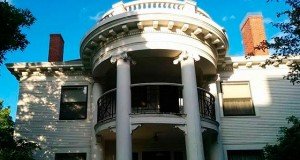A university-community advisory group is being formed to bridge community and HU
By JANE MCCLURE
New Hamline University President Fayneese Miller is telling campus neighbors and the activist group Historic Hamline Village to work together with her administration on the controversial issues of residential teardowns and campus expansion. But her message to “let it go” got a decidedly mixed reaction from a crowd of more than 125 people Oct. 14 at Hamline Church United Methodist.
With a self-imposed one-year moratorium on demolitions ending soon, many campus neighbors want to know what the new president has planned.
Miller’s message? “We are not ready to demolish a bunch of homes,” she said.
 Photo left: The "White House" at Hamline University, torn down as part of a number of properties that were demolished by Hamline University.
Photo left: The "White House" at Hamline University, torn down as part of a number of properties that were demolished by Hamline University.
That message was welcomed by neighbors who are still unhappy about the sudden demolition several months ago of homes along Hewitt Ave., and the destruction of the White House, the former on-campus president's home, a Greek Revival mansion. The university has a 2008 master plan that shows the demolition of 27 properties, mainly homes outside of the city-approved campus boundary. The recent loss of homes, as well as a citywide focus against residential teardowns, has galvanized the Historic Hamline Village group.
One focus was 1549 Minnehaha Ave., a home some neighbors want to be saved. Miller said there had been no offers yet on the property. It has been toured by interested parties. University staff has made sure the house is weatherproofed, and work has been done on the home’s exterior, but Miller has made no promises about the property’s future.
Miller repeatedly stressed her responsibilities for looking out for the university’s finances and economic health, noting that Hamline University is not a wealthy school. She defended the decision to tear down the White House by noting that it needed extensive work.
And while emphasizing that she wants to have a clean slate with neighbors and wants to do things differently than preceding administrations, Miller also made it clear that neighborhood preservation isn’t her top priority. Neighbors said they understood that but want it to be a priority. There were also some mixed feelings about being told to “let go” of what has been a hard-fought issue.
Miller also noted that one looming challenge is what to do with the university’s law school facilities when a planned merger with William Mitchell School of Law is completed.
Ward Four Council Member Russ Stark noted that while the request for a fresh start is understood, “The slate isn’t clean because there is history.” Stark said Miller’s attending the meeting was a chance to move forward.
Stark said he is looking for a funding source for a historic survey of the Hamline-Midway neighborhood. A survey could be used in the future if neighbors decide they want to seek conservation district status.
Historic Hamline Village spokespersons Robin Hemenway and Roy Neal reviewed their work over the past several months, restating their goals of saving homes and having a better relationship with the university. They outlined a list of priorities including asking that 1549 Minnehaha be saved and that a new campus master plan be considered.
Neal said that until Miller arrived, Hamline University didn’t see adjacent properties as historic. “They saw them as vacant lots,” he said. Neal, Hemenway and audience members said it’s important that the university considers creative solutions, such as selling back some homes, and using some homes as student houses for students learning a language or wanting to live with others who share their values and lifestyle.
Historic Hamline Village representatives also said they’d like better communications and ways to address what they see as inconsistencies between what the university is doing, and the district council and citywide comprehensive plan. One point repeatedly noted is that the neighborhood and city plans call for the preservation of homes.
Questions and comments from audience members were mixed. Some students spoke for more housing opportunities. Neighbors said they want better communication with the university. Some faculty members also criticized past school actions and said they hope a new administration is bringing positive change.
The group also reviewed an ongoing, citywide campus boundary study that is still being reviewed by the Planning Commission. A current recommendation that would affect the university is that if a lot’s primary structure is torn down within ten years, a college or university cannot add that property to its campus.
The meeting was also used to announce the formation of a university-community advisory group, the Hamline University Neighborhood Advisory Committee or HUNAC. It will include a representative from the University, Historic Hamline Village, HHV, Hamline Church United Methodist, neighbors, Hamline Midway Coalition, and the city.
Neighbors can apply for committee spots as well. Deadline is Nov. 15. Submit applications to Mariah Levison, Minnesota State Officer for Collaboration and Dispute Resolution. Applications may be submitted via email to Mariah.Levison@state.mn.us, or mailed to 1380 Energy Lane, Suite Two, St. Paul, MN 55108. Levison can send applicants a form. Committee members will be announced by Dec. 15.
Comments
No comments on this item Please log in to comment by clicking here